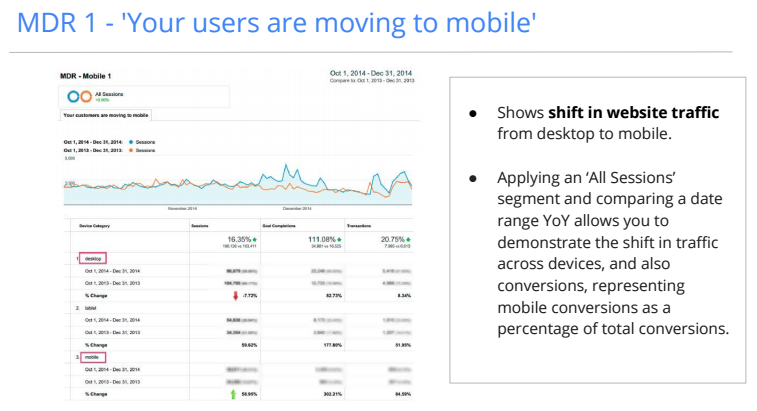Google Partners, Are You Ready To Rock!
This month High Position visited the Google HQ in London for the ‘Ready to Rock 2015’ presentation, part of the Google Partners initiative that is going from strength to strength. The event was an opportunity to find out how Google are helping Partner agencies deal with the growth in mobile advertising and understand conversions in a multi device landscape.

Anyone working in Digital Marketing over the last two years will be aware of the growth in mobile traffic across all sectors and in all regions. In the UK 40% of all online sales now take place on a smartphone or tablet, so it makes sense to take full advantage of this fact and have a digital marketing strategy that deals properly with the nuances associated with mobile search. It’s not enough to be aware this is happening; mobile search demands a different approach.
Position 1 for mobile is 3x more valuable than ranking in position 2

The Google Partners presentation began by debunking a few myths around mobile search. It was refreshing to hear that Google, and other agencies across the country, are facing the same challenges when it comes to convincing businesses that mobile search isn’t just for sharing pictures of cats or playing Candy Crush. These were the top five misconceptions, or barriers, around mobile advertising that were presented:
- Television is a stronger advertising platform
- Mobile is only used by young people
- It’s all about social media and entertainment
- Mobile sites are not very easy to use
- It’s difficult to measure performance
None of these statements are completely ridiculous; you might even find yourself agreeing with some or all of them, but each one only tells part of the story and when they are looked at in more detail they can no longer be taken as definitive truths.
- Yes television is a very strong advertising platform, but the way in which we watch TV has changed. 78% of the UK Internet population watch YouTube every month. In case you need reminding, YouTube is the second biggest search engine on the planet.
- It’s not just young people on mobile devices. Yes they may be the most visible group reaching for their phones at every opportunity but 74% of UK consumers have a smart phone, regardless of age, this is predicted to rise to 90% by 202.
- Social media is a big part of mobile usage but it’s not the whole story. We reach for our phones for all manner of tasks. Transferring money, getting directions, sending and receiving emails, asking advice and comparing prices are all commonplace on mobile devices.
- In respect of usability on mobile sites it’s very simple, mobile is growing and websites will have to cater for this audience. The businesses that get the most from mobile will be the ones that understand this and have a mobile site that is easy to use.
- Measuring mobile performance is, I’ll concede, the big challenge. The problem is that many businesses are still measuring the same things they were 3 years ago, they haven’t kept up with the changing trends in search behaviour. But it’s not impossible to measure the impact of mobile on a business. Yes, lead generation is still crucial but other things should be measured as well; telephone calls, cross device conversions, app downloads and site traffic are all influenced by mobile traffic.
One of the reasons for these misconceptions, in my opinion, is the speed with which mobile has grown and permeated our everyday lives in an almost stealth like manner. I can remember a friend telling me that watching videos on a phone would never catch on because of the size of the screen, yet today 45% of YouTube traffic is from mobile devices.
40% of UK online sales take place on a smartphone or tablet
So how do businesses tackle these challenges and what are Google doing to help? There are three things that will make the difference between getting a mobile digital marketing strategy right or wrong; research, measuring and reporting.
Do your research
The keyword planner will give you useful information on mobile trends within search. It’ll also give you information about what type of device is being used for a particular set of keywords. You can also get location information that for businesses with locations across the country can be invaluable. All of this information will tell you what opportunities are out there if you’re willing to go after them.
Your current PPC campaigns will give you the ability to look at what impact mobile is having on your business already, providing you’re opted into mobile search. Running reports with mobile segmentation will show you if you’re performing well or not. The Lost Impression Share and Auction Insights reports are a good place to start.
Measure twice, cut once…
…or don’t cut, just keep measuring! Measuring the impact of mobile traffic is tricky. One of the facts about current mobile usage that perfectly sums up the challenge here is that 65% of decisions start on a mobile device and end somewhere else. It’s a loaded stat because it shows how important mobile is but how difficult it can be to attached a sale, lead or conversion of any type to that first point of contact. How many of those journeys which started on mobile end several stages later on a desktop or even in store?
74% of UK consumers have a smartphone
In a multi device world measuring conversions is complicated. We know that traffic growth is being driven by mobile and desktop conversion rates are increasing. This indicates that people are using mobile to browse and research but are then converting on desktop. Because of this change it’s necessary to change the way we measure conversion rates. It’s no longer enough to measure in-device conversions, multi-device conversion rates show a more accurate picture of what is happening.
Report on the things that make a difference
Showing all this changing behaviour in traffic and conversions is the final piece in the puzzle, and this is where Google Analytics can really help. To be able to make good business decisions you need to be able to understand the changing search landscape and running some simple reports in GA will help you understand how changing trends are affecting your traffic and what visitors to your website are doing.

- Run a report that measures year on year growth across device to see how different devices impact on overall traffic and goals completions.
- Run a report that shows engagement metrics on mobile traffic. Comparing year on year data will show you how sessions and session duration have changed in twelve months. If your traffic mirrors recent trends both metrics will have increased significantly.
- Focus on desktop traffic only and run a report that shows how year on year traffic has change in respect of pages per session and session duration. If these figures are showing minimal growth or decline, but the overall conversion figure for your traffic is good then this is a good indicator that your desktop traffic has already done its research on a mobile device.
- Look at desktop traffic and see how much of that traffic converts within the first session. This would again indicate that users are likely to have conducted pre-conversion research on other devices and were then ready to convert on their first desktop session.
If you’ve got any questions about Mobile Advertising or Paid Search in general, contact our Paid Search team here, or call us on 0844 245 6677.










